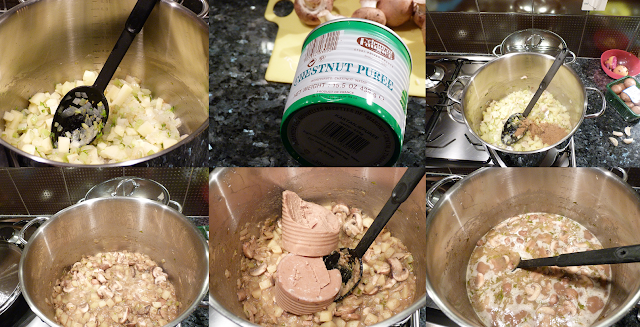
This starter is one of the 'world-class recipes' taken from the cookery book ‘Topkoks voor Thuiskoks No 3.' 'Top cooks for Home cooks 3'
The cookery book contains fifty two favourite recipes provided by fifty two national and international chefs. Each contributor was asked to donate a recipe suitable for the home cook.
It is however not just a cookbook; TNT Post partnered with WTP* (World Food programme) to realise this book and all proceeds go to WFP towards providing nourishing meals for schoolchildren. The raised money of each copy sold will enable 40 children to receive a nutritious meal at school in Malawi.
At 9,95euro, it makes an ideal gift. This is the third edition; the fourth is now available. I understand availability in the English language is very limited.

It is a beautifully illustrated cookbook with a selection of starter, main courses and desserts- to provide inspiration every week, for a whole year!
The "topkoks' / 'Top Chefs' include: Ferran Adrià- restaurant El Bulli, Spain, Herman den Blijker-tv chef- Herrie in de keuken, The Netherlands, Filip Claeys- Restaurant De Jonkman, Belgium, Ramon Beuk- TV chef 'Born2cook' The Netherlands, Sergio Herman- Restaurant Oud Sluis, The Netherlands.
I actually made this dish at a 'Drive and Cooking' event organised by Lexus. It was a perfect afternoon out- a combination of test driving Lexus Hybrid cars and cooking. The workshop took place at de Kookerij in Noordwijkerhout. The cars were impressive- and fast! The cooking part was also very well organised, the location beautiful- modern and well equipped. Part of the enjoyment was eating the food we prepared.
We didn't buy the car but ended up as proud owners of the cookbook!

de Kookerij in Noordwijkerhout
My Christmas dinner this year wasn't exactly traditional. I opted for the salmon tartar as starter.
The recipe we put together differed slightly to the one in the book, as does the tartar we made at the workshop, but it was quite delicious. The salmon needs to be very fresh since it is served raw. You could of course substitute with smoked salmon.
Marinated salmon tartar with avocado and lettuce- donated by Steffen Henssler, Restaurant ONO, Germany
Ingredients- 4 person
150gr salmon filet, cubed in small
1/2 ripe avocado, chopped finely
1 spring onion
2 el coriander, finely chopped
2 tsp chili sauce
1 - 2 tbsp olive oil
a dash of lime juice
1/2 iceberg lettuce
2 lemons, squeezed
2 oranges, squeezed
100g cream
100g crème fraiche
4 tbsp sugar
1 Mix the salmon with the avocado, spring onion and the coriander. Season with salt and pepper. Add the chili sauce, the olive oil and the lime juice and mix carefully.
2 Wash the lettuce, dry in a salad spinner and cut in bite size pieces. Mix the lemon and orange juice together. Add the cream and Crème fraiche. Season with salt and sugar.
Pour over the lettuce, toss and serve with the salmon tartar.
Of course I had to tweak. I reduced the sugar in the dressing- the quantity is also very generous, you could easily half the dressing ingredients. If you follow the instructions, you will make a kind of lettuce 'coleslaw'. I used mixed salad leaves, drizzled the dressing and left the jug on the table so everyone could help themselves. At the workshop we served the tartar with reconstituted sun dried tomato that were incredible!
I also have two non-fish eaters here, so it was necessary to improvise; I made two smoked chicken tartars with roughly the same ingredients, but used red onion instead of spring onion and added chopped tomatoes.

Smoked chicken tartar
It was Christmas so I had promised not to spend an awful lot of time shooting photo's! It was also quite chaotic in the kitchen, so the tartar is probably not as pretty as it could be, but it tasted good!
Salmon Tartar was not just on our Christmas menu, fellow Blogger Claudia had her own version.
* The World Food Programme (WFP) is the food aid branch of the United Nations, and the world's largest humanitarian organization addressing hunger worldwide. WFP provides food, on average, to 90 million people per year, 58 million of whom are children. (source: wikipedia)
Another recipe here.
